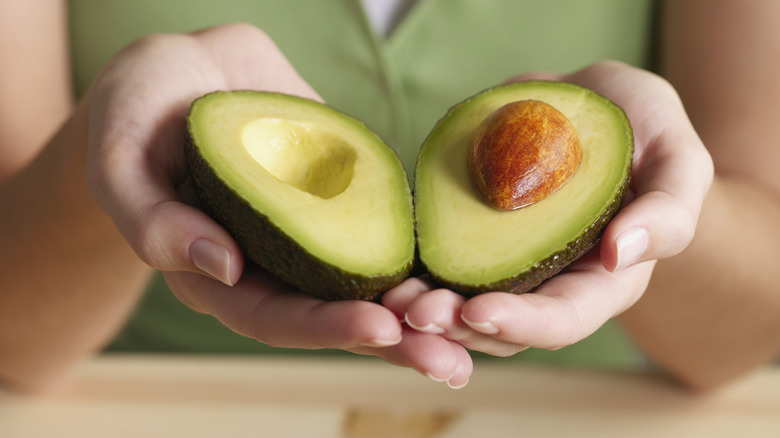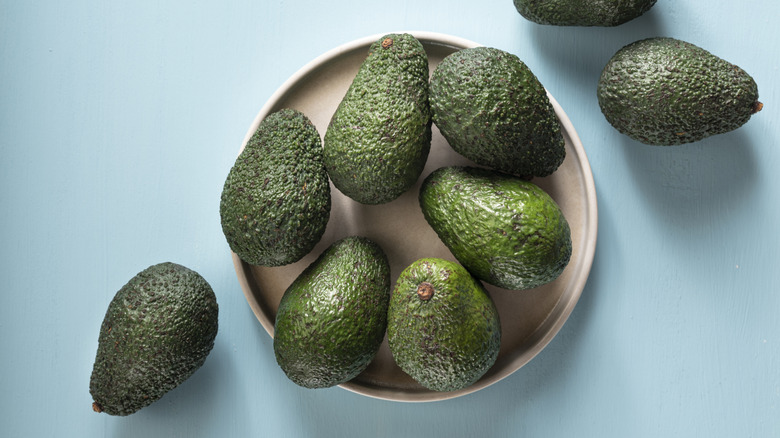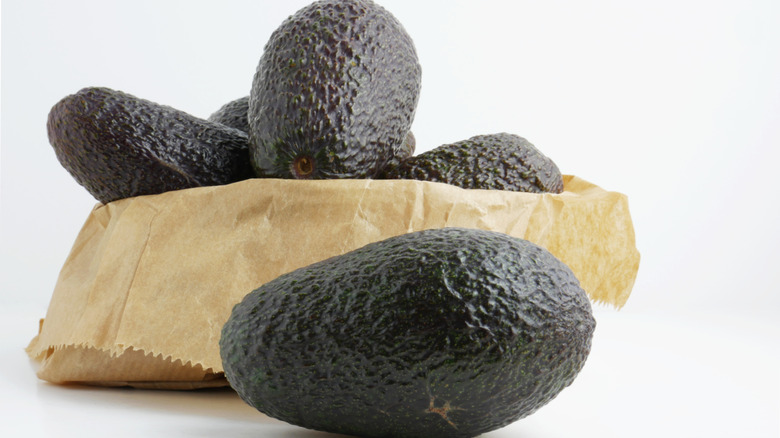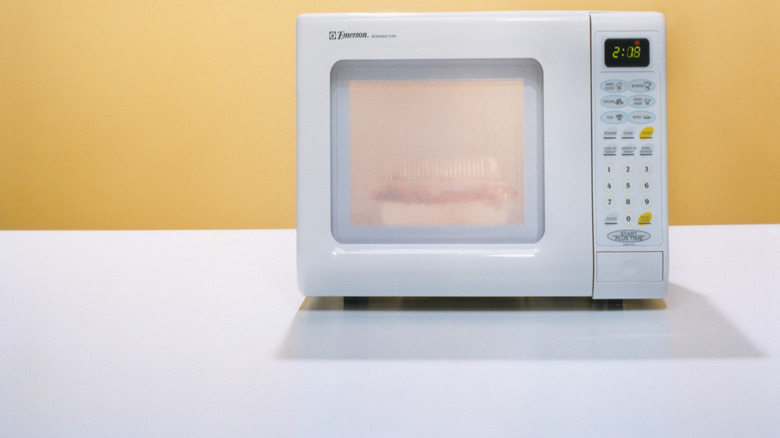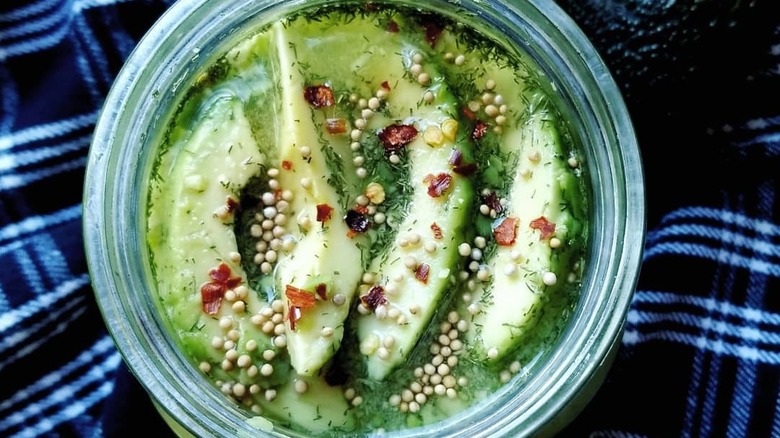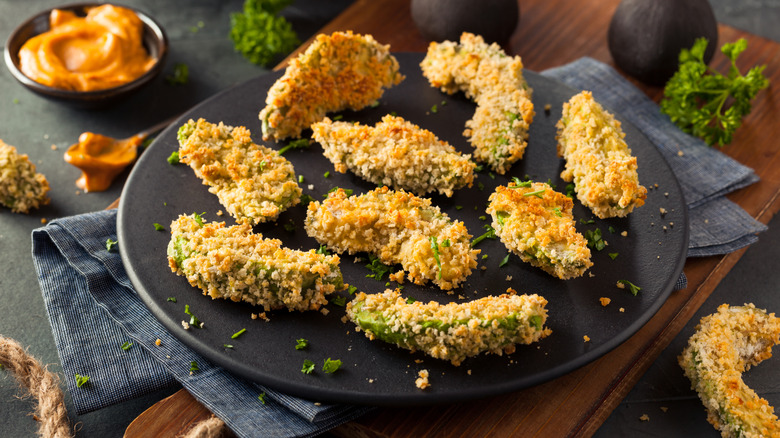5 Ways To Ripen An Avocado Faster
With avocados, what you see — a dark, rough exterior that may have helped to earn the fruit its nickname of alligator pear – isn't exactly what you get when you cut them open. Inside, you're hoping to see something smooth, creamy, pale green, and above all, the exact degree of ripeness necessary for making anything from avocado toast or homemade guacamole (check out this recipe from Voice of The Grinch Boris Karloff) to the meaty Mexican soup called carne en su jugo. Sometimes, however, you get an avocado that's still rock-hard, which means it was picked before it was ripe.
It helps if you're knowledgeable enough to pick out a perfect avocado from the store, which would be one with a bumpy skin so dark it's almost black and a texture soft enough to squeeze without being mushy. If you do purchase an avocado that's not quite ripe enough to use, though, you have a second chance to bring it up to speed. Avocados are classified as climacteric, which means that they produce ethylene gas that allows them to keep ripening even after they're picked. Here are the best methods.
Au naturel
One of the best ways to ripen an avocado, if you have the time, involves nothing more than letting it sit out in the sunlight (a windowsill would be ideal for this). The avocado will gently ripen over the course of a few days, although it could take up to a week if you start with a hard one. As it's right out there in full sight, though, you're more likely to remember to check it daily so that you'll know exactly when it's ripe enough to use.
Once a finger poke reveals that the avocado is sufficiently soft and yielding, refrigerate it right away to shut down the ripening process. Otherwise, you run the risk of it becoming overripe. If you don't think you'll be using the avocado right away, you may want to halt the ripening process when it's almost but not quite ripe, meaning it's still slightly firm when you poke it. An almost-ripe avocado should stay fresh in the fridge for up to five days.
In a paper wrapper
In order to speed up the ripening process a bit, you can wrap your avocado in a few sheets of newspaper or put it in a paper bag. The reason for doing so is that paper will hold and concentrate the ethylene gas that the avocado produces, which forces it into ripening more quickly than it otherwise would. It could still take three to six days to go from hard to soft, but that's one day sooner that you'll be enjoying guac and chips.
If you happen to have an apple, banana, or kiwi on hand (the fruit, not the bird), stick it in the paper bag along with the avocado. These fruits put out particularly high levels of ethylene and, when joined with the gas coming from the avocado, may cut the ripening time in half.
Another trick you may come across but we don't recommend involves burying the avocado in flour or rice inside that same paper bag. The theory behind doing so is that this supposedly concentrates the avocado's own ethylene more than paper alone and also absorbs any moisture. Well, the latter precaution seems unnecessary, as ripening avocados usually don't drip much. As for the former reason, the concentration boost may or may not work, but at any rate, it seems an unnecessary waste of either flour or rice.
In the oven or microwave
If you're a fan of TikTok kitchen hacks, you may have seen several videos recommending ripening an avocado in the microwave. The way to do this is to cut open the avocado and remove the pit, then cover both halves in plastic wrap (together or separately) and heat them for 30 seconds at a time. Repeat as necessary until the avocado flesh is soft. Another variant of the heat method involves baking the avocado at 200 degrees Fahrenheit for 10 minutes or so.
Critics of both techniques point out that the avocado isn't really ripening with the application of heat, but merely softening. The flavor, they say, won't be the same as an avocado that has been allowed to ripen with a more natural method. The texture, too, may not be quite as smooth, and the flesh may be watery. Still, if you're planning to use the avocado in a super-spicy guacamole recipe with plenty of mix-ins that will effectively camouflage any flavor or texture flaws, there's no denying that this method is by far the quickest way to take an avocado from rock-hard to squishably soft.
Quick-pickling
There is one other way that will allow you to soften an avocado without cooking it –- even one you may have mistakenly peeled and sliced before determining it was too unripe to use . This method involves quick-pickling the fruit by covering it with a brine made of equal parts water and white vinegar. The diluted vinegar bath will soften up the avocado in just two hours, leaving it pliable and fresh-tasting, albeit rather vinegary.
If you don't mind extra-tart guacamole, you could certainly use quick-pickled avocado for that purpose since it'll be soft enough to mash. It might be a bit tart for avocado toast but could certainly be used as a taco topper or to garnish a bowl of ramen noodles. If the flavor of pickled avocados is what you're going for, though, you can just keep the sliced avocados in the vinegar solution. In this case, you may also want to flavor the brine to taste with a few tablespoons of salt, sugar, and pickling spices.
Even an unripe avocado isn't a write-off
If you do slice into an unripe avocado but you'd rather not pickle or cook it to soften it up, you have another choice available to you. Underripe avocados, as it turns out, are perfect for making avocado fries since they're firm enough to hold their shape when sliced and fried.
To make avocado fries, take an unripe avocado and peel it, then cut it into fry-shaped wedges. Dredge these in flour, then dip them first into a beaten egg and then into breadcrumbs. Once the avocados have been coated in crumbs, fry them in an inch or so of oil until they're golden brown. For lower-fat avocado fries, you can squirt them with cooking spray and bake them at 400 degrees Fahrenheit for 12 to 14 minutes. Avocado fries can be eaten with ketchup, but they also taste great with a sriracha or chipotle mayonnaise dip or a squeeze of lime juice and a sprinkling of Tajín.
